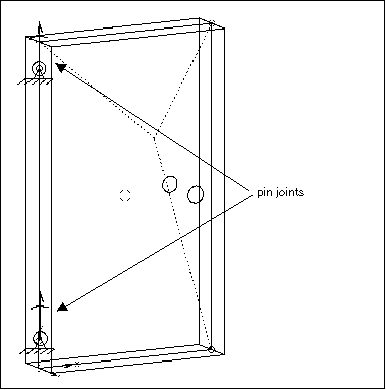To Calculate Degrees of Freedom and Redundancies
In most mechanical systems or models, you can determine the degrees of freedom using the following formula:
DOF = 6 x (number of bodies not including ground) – constraints
Suppose you model a door by using two pin joints to represent the two hinges:
This model has one body. Each of the two pin joints has 5 constraints. The equation becomes:
DOF = (6 x 1) – (2 x 5)
The result is – 4.
In this case, you want the DOF to equal 1. A swinging door has only one degree of rotational freedom. If you want to obtain reaction results for this model, you also need to take redundancies into account. The formula becomes:
DOF = 6 x (number of bodies not including ground) – constraints + redundancies
You can use this formula to solve for the redundancies in the door model with two pin joints:
1 = (6 x 1) – 10 + redundancies
1 = —4 + redundancies
5 = redundancies
In order for the model to have one DOF, you must eliminate five redundancies. A possible solution could be to replace the pin constraints with another type of constraint set. For instance, you could use a cylinder joint which has only one constraint. Make sure you choose the motion axes that allow the rotational motion you want.
The calculation below shows that this substitution reduces the redundancy to zero:
DOF – redundancy = 6 x (number of bodies not including ground) – constraints
DOF – redundancy = 6 x (number of bodies not including ground) – constraints
1 – redundancy = 1
Redundancy = 0
Use the Measure Results dialog box to obtain information on the redundancies in your mechanism.

